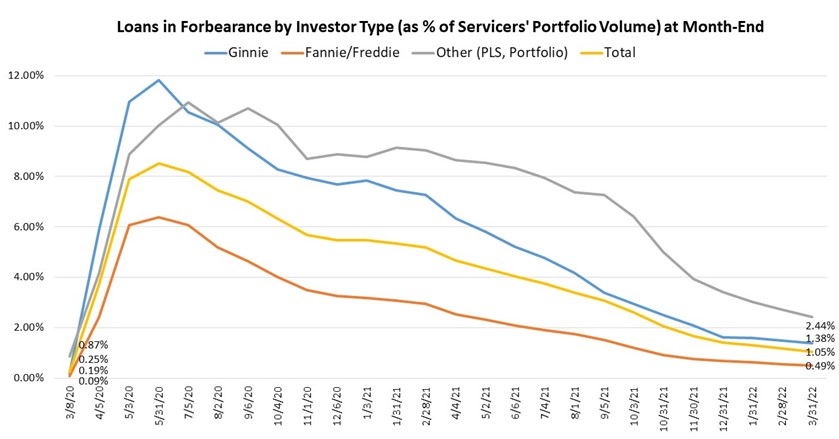Data: Share Of Loans In Forbearance In March Decreases
The Mortgage Bankers Association’s (MBA) monthly Loan Monitoring Survey revealed that the total number of loans now in forbearance decreased by 13 basis points from 1.18% of servicers’ portfolio volume in the prior month to 1.05% as of March 31, 2022. According to MBA’s estimate, 525,000 homeowners are in forbearance plans.
The share of Fannie Mae and Freddie Mac loans in forbearance decreased 7 basis points to 0.49%. Ginnie Mae loans in forbearance decreased 12 basis points to 1.38%, and the forbearance share for portfolio loans and private-label securities (PLS) declined 28 basis points to 2.44%.
“March was another month of lower forbearance rates, and a higher share of overall loans and forbearance-related workout loans that are current,” said Marina Walsh, CMB, MBA’s Vice President of Industry Analysis. “The share of loans in forbearance continues to dwindle and is just 5 basis points shy of hitting 1 percent – or 500,000 homeowners – after peaking at 4.3 million borrowers in June 2020. It has been a remarkable recovery for many homeowners in less than two years.”

Key findings of MBA’s Loan Monitoring Survey – March 1 to March 31, 2022:
- Total loans in forbearance decreased by 13 basis points in March 2022 relative to February 2022: from 1.18% to 1.05%.
- By investor type, the share of Ginnie Mae loans in forbearance decreased relative to the prior month: from 1.50% to 1.38%.
- The share of Fannie Mae and Freddie Mac loans in forbearance decreased relative to the prior month: from 0.56% to 0.49%.
- The share of other loans (e.g., portfolio and PLS loans) in forbearance decreased relative to the prior month: from 2.72% to 2.44%.
- Loans in forbearance as a share of servicing portfolio volume (#) as of March 31, 2022:
- Total: 1.05% (previous month: 1.18%)
- Independent Mortgage Banks (IMBs): 1.29% (previous month: 1.44%)
- Depositories: 0.86% (previous month: 0.97%)
- By stage, 29.7% of total loans in forbearance are in the initial forbearance plan stage, while 57.2% are in a forbearance extension. The remaining 13.1% are forbearance re-entries, including re-entries with extensions.
- Of the cumulative forbearance exits for the period from June 1, 2020, through March 31, 2022, at the time of forbearance exit:
- 29.2% resulted in a loan deferral/partial claim.
- 18.9% represented borrowers who continued to make their monthly payments during their forbearance period.
- 17.1% represented borrowers who did not make all of their monthly payments and exited forbearance without a loss mitigation plan in place yet.
- 15.4% resulted in a loan modification or trial loan modification.
- 11.4% resulted in reinstatements, in which past-due amounts are paid back when exiting forbearance.
- 6.7% resulted in loans paid off through either a refinance or by selling the home.
- The remaining 1.3% resulted in repayment plans, short sales, deed-in-lieus or other reasons.
- Total loans serviced that were current (not delinquent or in foreclosure) as a percent of servicing portfolio volume (#) rose to 95.47% in March 2022 from 94.94% in February 2022 (on a non-seasonally adjusted basis).
- The five states with the highest share of loans that were current as a percent of servicing portfolio: Idaho, Washington, Colorado, Utah, and Oregon.
- The five states with the lowest share of loans that were current as a percent of servicing portfolio: Louisiana, Mississippi, New York, West Virginia, and Oklahoma.
- Total completed loan workouts from 2020 and onward (repayment plans, loan deferrals/partial claims, loan modifications) that were current as a percent of total completed workouts rose to 83.67% last month from 82.26% in February.

The Place for Lending Visionaries and Thought Leaders. We take you beyond the latest news and trends to help you grow your lending business.



